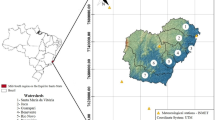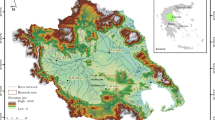Abstract
Water fluxes in slopes are affected by climatic conditions and vegetation cover, which influence the effective stress and stability. The vegetation cover is the intermediate layer between the atmosphere and the slope surface that alter water balance in the slope through evapotranspiration and leaf interception. This paper studies the data-driven approach for predicting the macro stability of an example grass-covered dike based on actual data and also synthetic data provided by numerical modelling. Two numerical models are integrated in this study. The water balance in the root zone is simulated through a crop model, whereas the hydro-mechanical and safety analysis of the example dike is done using a two-dimensional Finite Element model. The considered period for these analyses is 10 years (3650 daily instances) which will be used to generate a time-series dataset for a secondary dike in the Netherlands. The features included in the dataset are parameters that (i) have a meaningful relationship with the dike Factor of safety (FoS), and (ii) can be observed using satellite remote sensing. The output dataset is used to train a Random Forest regressor as a supervised Machine Learning (ML) algorithm. The results of this proof-of-concept study indicate a strong correlation between the numerically estimated FoS and the ML-predicted one. Therefore, it can be suggested that the utilized parameters can be used in a data-driven predictive tool to identify vulnerable zones along a dike without a need for running expensive numerical simulations.
Access this chapter
Tax calculation will be finalised at checkout
Purchases are for personal use only
Similar content being viewed by others
References
Ada M, San BT (2018) Comparison of machine-learning techniques for landslide susceptibility mapping using two-level random sampling (2LRS) in Alakir catchment area, Antalya, Turkey. Nat Hazards 90(1):237–263
Bouman BAM, Schapendonk AHCM, Stol W, van Kraalingen DWG (1996) Description of the growth model LINGRA as implemented in CGMS. In: Quantitative Approaches in System Analysis, vol 7. DLO Research Institute for Agrobiology and Soil, Wageningen, the Netherlands
Breiman L (2001) Random forests. Mach Learn 45(1):5–32. Springer
Burkov A (2019) The hundred—page machine learning. In: (part of title) And add publication details, vol 1. ndriy Burkov Quebec City, Canada
de Vries G (2012) Monitoring droogteonderzoek veenkaden, Report no. 1203255-006-GEO-0001-gbh, Deltares, Delft
Elia G et al (2017) Numerical modelling of slope–vegetation–atmosphere interaction: an overview. Q J Eng Geol Hydrogeol 50:249–270
Ferretti A, Prati C, Rocca F (2001) Permanent scatterers in SAR interferometry. IEEE Trans Geosci Remote Sens 39(1):8–20
Ghorbanzadeh O, Blaschke T, Gholamnia K, Meena SR, Tiede D, Aryal J (2019) Evaluation of different machine learning methods and deep-learning convolutional neural networks for landslide detection. Remote Sens 11(2):196
Jamalinia E, Vardon PJ, Steele-Dunne SC (2019a) Can vegetation indices predict slope (stability) conditions? In: Geophysical Research Abstracts, vol 21, pp 55–64
Jamalinia E, Vardon PJ, Steele-Dunne SC (2019b) The effect of soil–vegetation–atmosphere interaction on slope stability: a numerical study. Environ Geotech ahead of print 1–12
Jamalinia E, Vardon PJ, Steele-Dunne SC (2020a) The impact of evaporation induced cracks and precipitation on temporal slope stability. Comput Geotech 122:103506
Jamalinia E, Vardon P, Steele-Dunne S (2020b) Use of displacement as a proxy for dike safety. Proc Int Assoc Hydrol Sci 382(1):481–485
Jamalinia E, Tehrani FS, Steele-Dunne SC, Vardon PJ (2020c) A data-driven approach for stability forecasting of dikes. in prepara
Lin Y, Zhou K, Li J (2018) Prediction of slope stability using four supervised learning methods. IEEE Access 6:31169–31179
Özer IE, van Leijen FJ, Jonkman SN, Hanssen RF (2018) Applicability of satellite radar imaging to monitor the conditions of levees. J Flood Risk Manag 12(Suppl. 2):e12509
Plaxis BV (2018) PLAXIS reference manual 2018. Delft, Netherlands
Pourghasemi HR, Rahmati O (2018) Prediction of the landslide susceptibility: which algorithm, which precision? Catena 162:177–192
Qi C, Tang X (2018) Slope stability prediction using integrated metaheuristic and machine learning approaches: a comparative study. Comput Ind Eng 118(February):112–122
Rodriguez D, van Oijen M, Schapendonk AHMC (1999) LINGRA-CC: a sink-source model to simulate the impact of climate change and management on grassland productivity. New Phytol v 144(2):359–368
Acknowledgements
This work is part of the research program Reliable Dikes with project number 13864 which is financed by the Netherlands Organisation for Scientific Research (NWO).
Author information
Authors and Affiliations
Corresponding author
Editor information
Editors and Affiliations
Rights and permissions
Copyright information
© 2021 Springer Nature Switzerland AG
About this chapter
Cite this chapter
Jamalinia, E., Tehrani, F.S., Steele-Dunne, S.C., Vardon, P.J. (2021). Predicting Rainfall Induced Slope Stability Using Random Forest Regression and Synthetic Data. In: Arbanas, Ž., Bobrowsky, P.T., Konagai, K., Sassa, K., Takara, K. (eds) Understanding and Reducing Landslide Disaster Risk. WLF 2020. ICL Contribution to Landslide Disaster Risk Reduction. Springer, Cham. https://doi.org/10.1007/978-3-030-60713-5_24
Download citation
DOI: https://doi.org/10.1007/978-3-030-60713-5_24
Published:
Publisher Name: Springer, Cham
Print ISBN: 978-3-030-60712-8
Online ISBN: 978-3-030-60713-5
eBook Packages: Earth and Environmental ScienceEarth and Environmental Science (R0)




